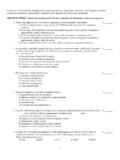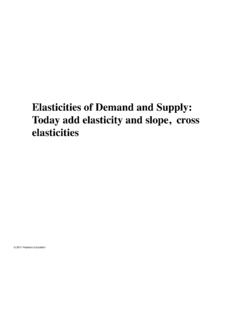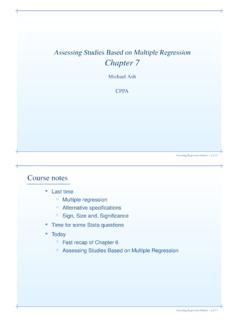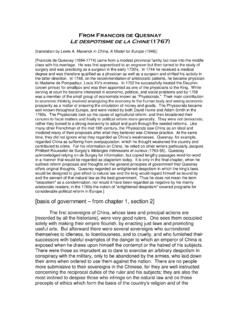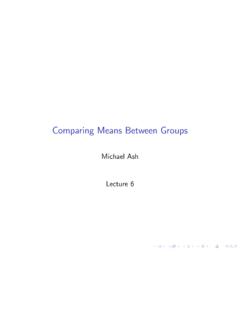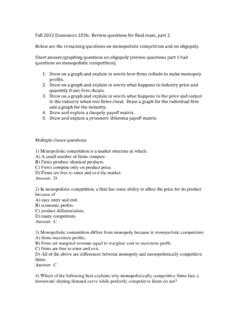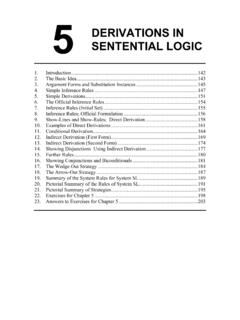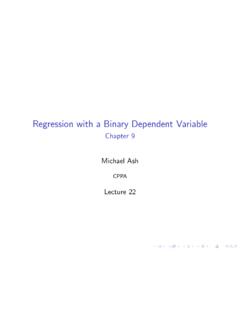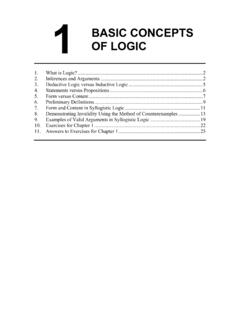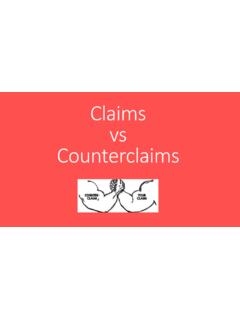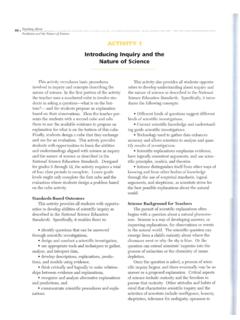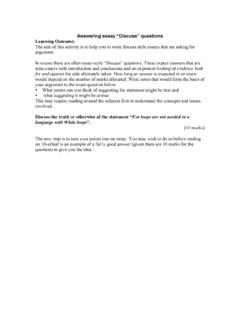Transcription of BASIC CONCEPTS OF LOGIC - UMass
1 BASIC CONCEPTS OF LOGIC 1. What is LOGIC ? ..2 2. Inferences and Arguments ..2 3. Deductive LOGIC versus Inductive LOGIC ..5 4. Statements versus 5. Form versus 6. Preliminary 7. Form and Content in Syllogistic 8. Demonstrating Invalidity Using the Method of Counterexamples ..13 9. Examples of Valid Arguments in Syllogistic LOGIC ..19 10. Exercises for Chapter 11. Answers to Exercises for Chapter 2 Hardegree, Symbolic LOGIC 1. WHAT IS LOGIC ? LOGIC may be defined as the science of reasoning. However, this is not to suggest that LOGIC is an empirical ( , experimental or observational) science like physics, biology, or psychology. Rather, LOGIC is a non-empirical science like mathematics. Also, in saying that LOGIC is the science of reasoning, we do not mean that it is concerned with the actual mental (or physical) process employed by a thinking entity when it is reasoning.
2 The investigation of the actual reasoning proc-ess falls more appropriately within the province of psychology, neurophysiology, or cybernetics. Even if these empirical disciplines were considerably more advanced than they presently are, the most they could disclose is the exact process that goes on in a being's head when he or she (or it) is reasoning. They could not, however, tell us whether the being is reasoning correctly or incorrectly. Distinguishing correct reasoning from incorrect reasoning is the task of LOGIC . 2. INFERENCES AND ARGUMENTS Reasoning is a special mental activity called inferring, what can also be called making (or performing) inferences. The following is a useful and simple definition of the word infer . To infer is to draw conclusions from premises. In place of word premises , you can also put: data , information , facts.
3 Examples of Inferences: (1) You see smoke and infer that there is a fire. (2) You count 19 persons in a group that originally had 20, and you infer that someone is missing. Note carefully the difference between infer and imply , which are sometimes confused. We infer the fire on the basis of the smoke, but we do not imply the fire. On the other hand, the smoke implies the fire, but it does not infer the fire. The word infer is not equivalent to the word imply , nor is it equivalent to insinuate . The reasoning process may be thought of as beginning with input (premises, data, etc.) and producing output ( conclusions ). In each specific case of drawing (inferring) a conclusion C from premises P1, P2, P3, .., the details of the actual mental process (how the "gears" work) is not the proper concern of LOGIC , but of psychology or neurophysiology.
4 The proper concern of LOGIC is whether the infer-ence of C on the basis of P1, P2, P3, .. is warranted (correct). Inferences are made on the basis of various sorts of things data, facts, infor-mation, states of affairs. In order to simplify the investigation of reasoning, LOGIC Chapter 1: BASIC CONCEPTS 3 treats all of these things in terms of a single sort of thing statements. LOGIC corre-spondingly treats inferences in terms of collections of statements, which are called arguments. The word argument has a number of meanings in ordinary English. The definition of argument that is relevant to LOGIC is given as follows. An argument is a collection of statements, one of which is designated as the conclusion, and the remainder of which are designated as the premises. Note that this is not a definition of a good argument.
5 Also note that, in the context of ordinary discourse, an argument has an additional trait, described as follows. Usually, the premises of an argument are intended to support (justify) the conclusion of the argument. Before giving some concrete examples of arguments, it might be best to clarify a term in the definition. The word statement is intended to mean declarative sentence. In addition to declarative sentences, there are also interrogative, imperative, and exclamatory sentences. The sentences that make up an argument are all declarative sentences; that is, they are all statements. The following may be taken as the official definition of statement . A statement is a declarative sentence, which is to say a sentence that is capable of being true or false. The following are examples of statements.
6 It is raining I am hungry 2+2 = 4 God exists On the other hand the following are examples of sentences that are not statements. are you hungry? shut the door, please #$%@!!! (replace #$%@!!! by your favorite expletive) Observe that whereas a statement is capable of being true or false, a question, or a command, or an exclamation is not capable of being true or false. Note that in saying that a statement is capable of being true or false, we are not saying that we know for sure which of the two (true, false) it is. Thus, for a sentence to be a statement, it is not necessary that humankind knows for sure whether it is true, or whether it is false. An example is the statement God exists . 4 Hardegree, Symbolic LOGIC Now let us get back to inferences and arguments. Earlier, we discussed two examples of inferences.
7 Let us see how these can be represented as arguments. In the case of the smoke-fire inference, the corresponding argument is given as follows. (a1) there is smoke (premise) therefore, there is fire (conclusion) Here the argument consists of two statements, there is smoke and there is fire . The term therefore is not strictly speaking part of the argument; it rather serves to designate the conclusion ( there is fire ), setting it off from the premise ( there is smoke ). In this argument, there is just one premise. In the case of the missing-person inference, the corresponding argument is given as follows. (a2) there were 20 persons originally (premise) there are 19 persons currently (premise) therefore, someone is missing (conclusion) Here the argument consists of three statements there were 20 persons originally , there are 19 persons currently , and someone is missing.
8 Once again, therefore sets off the conclusion from the premises. In principle, any collection of statements can be treated as an argument simply by designating which statement in particular is the conclusion. However, not every collection of statements is intended to be an argument. We accordingly need criteria by which to distinguish arguments from other collections of statements. There are no hard and fast rules for telling when a collection of statements is intended to be an argument, but there are a few rules of thumb. Often an argument can be identified as such because its conclusion is marked. We have already seen one conclusion-marker the word therefore . Besides therefore , there are other words that are commonly used to mark conclusions of arguments, including consequently , hence , thus , so , and ergo.
9 Usually, such words indicate that what follows is the conclusion of an argument. Other times an argument can be identified as such because its premises are marked. Words that are used for this purpose include: for , because , and since . For example, using the word for , the smoke-fire argument (a1) earlier can be rephrased as follows. (a1 ) there is fire for there is smoke Note that in (a1 ) the conclusion comes before the premise. Other times neither the conclusion nor the premises of an argument are marked, so it is harder to tell that the collection of statements is intended to be an argument. A general rule of thumb applies in this case, as well as in previous cases. Chapter 1: BASIC CONCEPTS 5 In an argument, the premises are intended to support (justify) the conclusion.
10 To state things somewhat differently, when a person (speaking or writing) advances an argument, he(she) expresses a statement he(she) believes to be true (the conclusion), and he(she) cites other statements as a reason for believing that state-ment (the premises). 3. DEDUCTIVE LOGIC VERSUS INDUCTIVE LOGIC Let us go back to the two arguments from the previous section. (a1) there is smoke; therefore, there is fire. (a2) there were 20 people originally; there are 19 persons currently; therefore, someone is missing. There is an important difference between these two inferences, which corresponds to a division of LOGIC into two branches. On the one hand, we know that the existence of smoke does not guarantee (ensure) the existence of fire; it only makes the existence of fire likely or probable. Thus, although inferring fire on the basis of smoke is reasonable, it is nevertheless fallible.
